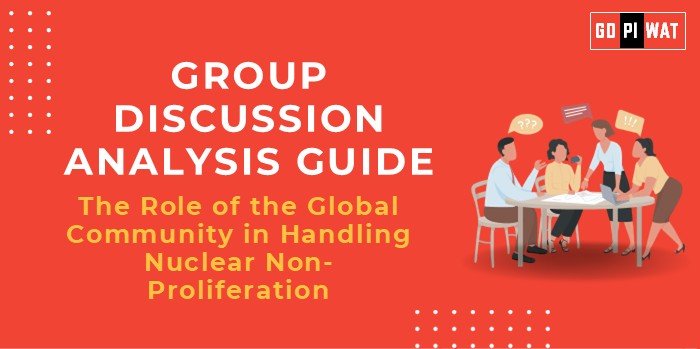📋 Group Discussion (GD) Analysis Guide
🌍 The Role of the Global Community in Handling Nuclear Non-Proliferation
🌐 Introduction to Nuclear Non-Proliferation
📖 Opening Context
Nuclear weapons pose an existential threat to humanity. The global community’s efforts in nuclear non-proliferation aim to prevent the spread of such weapons while promoting disarmament and the peaceful use of nuclear energy.
📜 Topic Background
The Treaty on the Non-Proliferation of Nuclear Weapons (NPT), established in 1970, serves as the cornerstone for global nuclear disarmament and non-proliferation efforts. Recent geopolitical tensions, advancements in nuclear technology, and violations by states underline the topic’s urgency.
📊 Quick Facts and Key Statistics
- 🌍 NPT Signatories: 191 countries—except India, Pakistan, and Israel.
- ☢️ Nuclear Warheads Worldwide: ~13,000 (2023) concentrated in nine countries.
- 💰 Budget Allocations: U.S. nuclear arsenal modernization (~$634 billion by 2030).
- ⚠️ Recent Violations: Iran’s enrichment of uranium to 60%, close to weapons-grade levels.
🤝 Stakeholders and Their Roles
- 🏛️ United Nations (UN): Enforces resolutions, facilitates negotiations (e.g., IAEA).
- 🔬 IAEA: Monitors compliance with non-proliferation treaties.
- 🌐 Nuclear Weapon States (NWS): Play critical roles in setting disarmament precedents.
- 📢 Non-Nuclear Weapon States (NNWS): Advocate for equitable disarmament.
- 🌱 Civil Society & NGOs: Push for treaties like the Treaty on the Prohibition of Nuclear Weapons (TPNW).
🏆 Achievements and Challenges
✨ Achievements
- ✅ NPT Success: Prevented widespread nuclear weapon proliferation.
- 🤝 START Treaty: Bilateral reductions between U.S. and Russia (93% of nuclear stockpiles).
- 🛡️ IAEA Oversight: Comprehensive safeguards and inspections globally.
⚠️ Challenges
- 🚨 Treaty Violations: Iran and North Korea’s defiance.
- 💣 Modernization Trends: U.S. and Russia investing heavily in new arsenals.
- 🌎 Lack of Universality: Key nations like India, Pakistan, and Israel remain outside the NPT.
🌍 Global Comparisons
- 🌟 Success: South Africa voluntarily dismantled its nuclear arsenal.
- ❌ Challenge: North Korea’s withdrawal from NPT and nuclear tests.
📚 Case Studies
- 📖 Iran Nuclear Deal (JCPOA): Initially successful in limiting enrichment but faced setbacks after the U.S. withdrawal in 2018.
💡 Structured Arguments for Discussion
- ✅ Supporting Stance: “The NPT has largely succeeded in preventing new nuclear states, saving the world from potential arms races in volatile regions.”
- 🛑 Opposing Stance: “The treaty is ineffective; countries like North Korea developed weapons while remaining parties face discriminatory policies.”
- ⚖️ Balanced Perspective: “While the NPT has curbed proliferation, emerging technologies and geopolitical tensions demand a stronger, more inclusive framework.”
🎯 Effective Discussion Approaches
- 📊 Opening Approaches:
- Start with historical milestones like the Cuban Missile Crisis and NPT’s origin.
- Highlight recent violations and their implications on global security.
- ⚡ Counter-Argument Handling:
- Emphasize international cooperation, e.g., Iran Nuclear Deal’s potential revival.
- Suggest technology controls and trust-building measures as solutions.
🧠 Strategic Analysis: SWOT
- 💪 Strengths: Global frameworks, multilateral treaties, technological safeguards.
- 🛠️ Weaknesses: Geopolitical rivalries, lack of universality, treaty violations.
- 🌟 Opportunities: Renewed diplomacy, advanced detection technology.
- ⚠️ Threats: Emerging nuclear states, cyber threats to arsenals.
🏫 Connecting with B-School Applications
📚 Real-World Applications
- International diplomacy, risk assessment, and strategic planning.
🎓 Sample Interview Questions
- ❓ “How can global alliances strengthen nuclear non-proliferation efforts?”
- ❓ “Evaluate the impact of technology on nuclear disarmament policies.”
📘 Insights for Students
- 💡 Link frameworks to leadership in global projects, balancing national and international interests.


